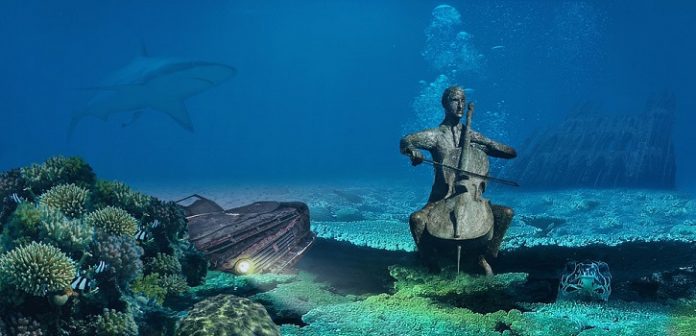If you enjoy elaborate artwork and the beauty of being underwater, you’ve probably heard of underwater sculpture gardens. The concept of creating a group of sculptures that an artist designed to be underwater has been around for quite some time. A number of these sculptures have become part of the underwater ecosystem since animals live in the structures. Aquatic plants also grow on many of the sculptures and creatures in the seas and oceans use these plants for food. However, the more modern works depict certain societal concepts. Many of these sculptures are especially thought-provoking and give people a new appreciation for art. If you plan to visit an area that features underwater sculpture gardens, here are some interesting things you should know.
Jason deCaires Taylor Sculptures
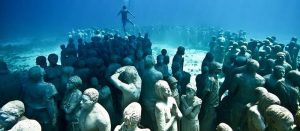
Jason deCaires Taylor is an artist who has been getting lots of notoriety for his sculptures. The artwork sits on the ocean floor and is made from steel and concrete. The sculptures are beautiful and are a great environment for filter-feeding creatures. Taylor’s creative underwater works are important to the ocean wildlife and to those who can swim to the statues.
The sculptures are 2 to 8 meters under the surface of the water. Taylor has created more than 65 sculptures as part of his art collection. Several species live in them, including juvenile striped parrot fish, peacock flounder, fire worms, and banded coral shrimp. The sculptures are in waters that are crystal clear and fairly shallow. This means it is easy for people in glass-bottom boats to see the artwork. Snorkelers and divers can see the sculpture garden easily as well.
Some pieces are as heavy as 15 tons, but this doesn’t mean the sculptures can’t be affected by nature. A hurricane destroyed Grace Reef, Taylor’s first sculpted work. However, the British artist says that destruction is an important part of his work. He says that the sculptures interact with the underwater elements in a number of ways. Some interactions are unpredictable and can even make the art more interesting. As the years progress, some sculptures could dissolve into the ocean. This is yet another indication that nature and art are always intertwined.
Sculptures Around the World
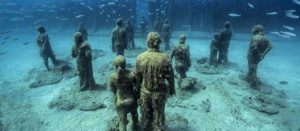
In addition to Taylor’s beautiful cement-based underwater creations, there are also underwater sculptures in Grenada that attract tourists every year.
Moliere Bay, which has 65 underwater sculptures, covers about 800 square meters. The attraction is just 2 miles from St. Georges (the capital), which is in the western region of the island. The area is a National Marine Park. Rock headlands close off this beautiful area and there is a small beach. This makes it easy to relax on the shore after you have seen the beautiful art under the water. The depth of the water ranges from 0 to 25 meters. You can walk to the attraction via Dragon Bay, and follow the beach. Or, you can take a 10-minute ride on a boat from St. Georges to get to the rock sculptures. If you decide to stay in Grand Anse, the boat ride is 15 minutes.
The area is one of the best places to go snorkeling and is a Marine Protected Area. This is an ideal location for experiencing the culture of Grenada. A number of materials make up the sculptures, including rebar and concrete, and they reflect the island’s diversity. The structures settle underwater and they attract several types of marine life. The sculptures become the homes for small sea creatures. The combination of water and concrete also makes an ideal breeding area for certain underwater plants. Natural occurrences also affect the shape and look of the sculptures. Water pressure, currents, weather, and the pattern of the waves ensure that no two statues look exactly the same.
Since they have become a source of food and shelter, these artificial reefs also take less pressure off the environment. The artwork sustains the marine life in other ways as well. This motivates people to be more mindful of how they care for the ocean. Hopefully, this trend will become more evident even in places where there are no underwater sculptures.
Sculpture Descriptions
If you want to learn a little more about the sculptures before a visit, here are some detailed descriptions. Getting an understanding of the artists’ vision could help you have a great appreciation for the underwater sculpture gardens you see.
Vicissitudes
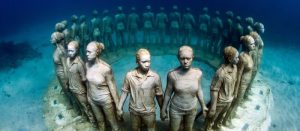
This sculpture includes life-size statues that were cast from children who live in the area. The artwork shows the children holding hands in a circle. The sculpture will go through changes as a result of the environment. The artwork has to adapt to its surroundings in order to survive. However, this means that the sculpture will eventually look much different from it did when the artist first constructed it. This indicates the changes that children will go through as they become adults. The artwork is about 5 meters into the water. Concrete and hard substrate form the artwork, and that makes it easy for coral to grow.
The Lost Correspondent

This sculpture is of a man working at a desk. There is a typewriter on the desk, along with newspaper clippings. Some clippings detail historic events, such as Grenada being involved with Cuba. The artwork explores social changes, communication, and the way society receives information. The artwork is in 7 meters of water, and a natural gully protects it. So, the sculpture naturally looks as though it is in an office setting.
Grace Reef
This awe-inspiring sculpture has 16 female figures lying across the reef. A Grenadian woman was the subject of the statues. The sea will affect the figures, and they will accept any changes that the water will inflict on them. The activity of the water sometimes hides the sculpture. Other times, there is no activity and divers can see the artwork. This beautiful and thought-provoking sculpture is a favorite among tourists who are able to witness it.
Sienna
This underwater sculpture is especially elegant and shows a skin diver. The diver is part of a story that islanders like to tell. The structure of the statue is simple. The figure is made of metal strands that the artist wove together. This means the flow of the water affects the structure. Over the years, the structure has become home to several types of marine life.
Man On a Bike
This sculpture looks like there is a man riding a bike along the reef. The artists salvaged the bicycle. The body language of the rider is both relaxed and resolved.
TAM CC Faces
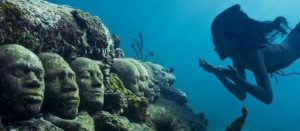
Local community college students helped create this project. A coral boulder has several faces that are true to size sculpted into it. The faces sit cheek to cheek, making it easy to notice the variety in ethnic features and expressions. The sculpture has become home to algae and truncates.
The Unstill Life
This underwater sculpture appears to be a conventional piece, like the bowl of fruit positioned on the table. The artwork shows that there will always be changes to art and different takes on creativity. A number of marine life forms have colonized the sculpture, including sponges and coral.
Disclaimer: All images are copyright to their respective owners and are used by USA Online Casino for informational purposes only.


